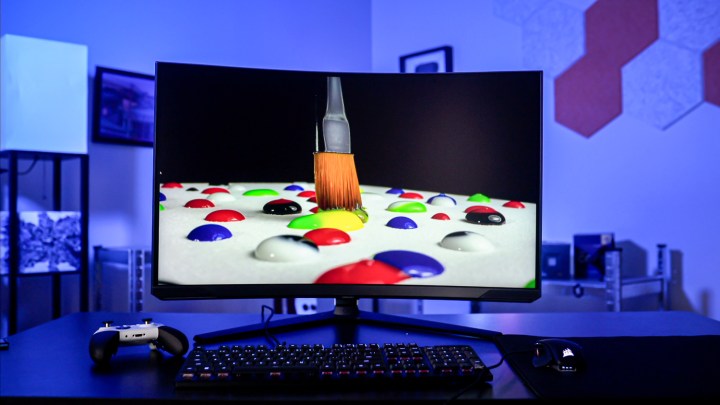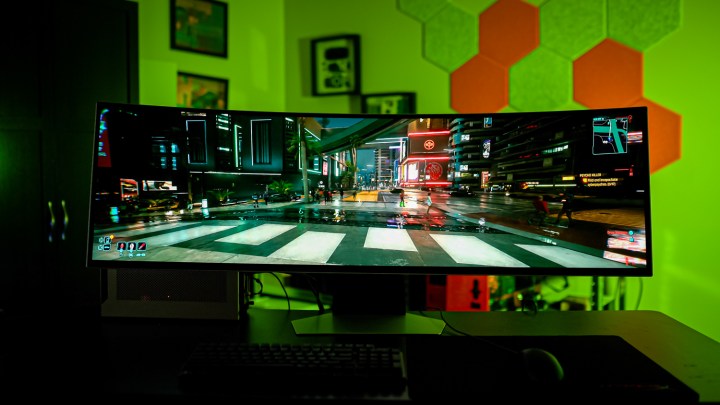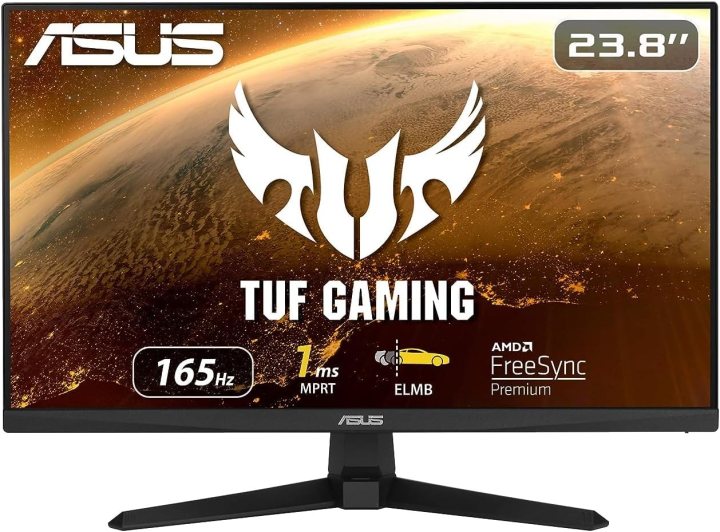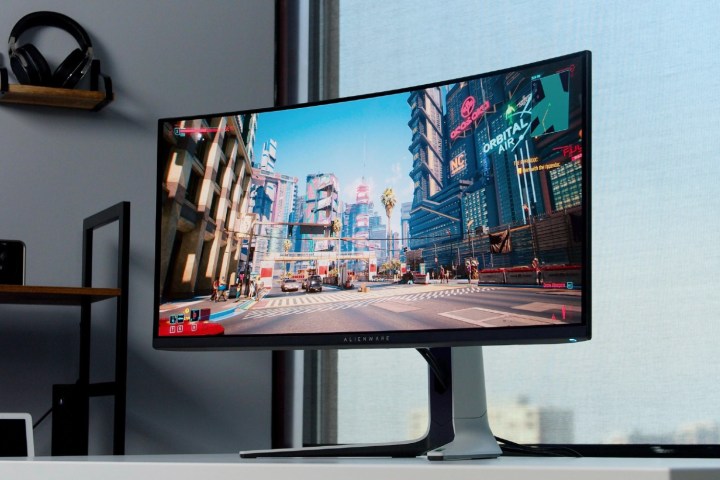You need more than a high refresh rate to earn a spot among the best gaming monitors. There's no shortage of displays that want to hop on the gaming monitor bandwagon, but you shouldn't pick up any display that slaps "gaming" on its product packaging. From budget showstoppers to the latest high-end OLED options, we're hear to help you navigate the sometimes murky waters of gaming monitors.
We didn't just look at a couple of displays and throw them into a list. Testing gaming displays involves dozens of hours of testing, validation, and comparison to other options, and that's before digging into additional features. Not only have we reviewed countless gaming monitors over the years, we've also used them day in and day out to see if they hold up over time.
Investing in one of the best gaming monitors will not only level up your PC or console gaming experience; it'll also set you up for years of upgrades in the future. Your gaming monitor is the last line of defense for a fantastic gaming experience, so carefully consider the options here before making a decision.








The best gaming monitor
HP Omen Transcend 32
- Fantastic color quality
- Multi-purpose KVM switch
- Up to 140W of power delivery
- Robust on-screen display
- High peak HDR brightness
- Massive power brick
- Poor cable management solution
| Specification: | |
| Screen size | 32 inches |
| Panel type | QD-OLED |
| Resolution | 3,840 x 2,160 (4K) |
| Refresh rate | 240Hz |
| HDR | DisplayHDR True Black 400 |
There's no monitor that does it all quite like the HP Omen Transcend 32, and that's why it's the gaming display I recommend most. It's not inexpensive, but HP goes out of its way to pack the Omen Transcend 32 with so many features that the price is easily justified. I've reviewed dozens of monitors packing this same panel, and the fact that this monitor manages to stand out at all is a feat.
For the panel itself, it's just about perfect. The monitor produces the widest color coverage I've ever measured, and flew just short of 1,000 nits for the brightest highlights. I was a bit disappointed in the out-of-box color performance, where I measured a color error of just over 1. Still, that's totally usable for most situations, and if you perform some basic calibration, the Omen Transcend 32 can even put extremely color accurate displays like the Alienware 32 QD-OLED to shame.
But really, it's everything outside of the panel that makes this monitor stand out. A massive 480-watt power brick offers up 140W through the USB-C input, as well as power to the five additional USB ports available as a hub. This USB hub is incredible. With it, you can use Omen Gear Switch, which allows you to transfer your peripherals between inputs instantly. You can even transfer files between two PCs, which is handled entirely inside the monitor.
My favorite feature of the monitor is actually the menu. Seriously. HP gives you a gaming menu and a creator menu, and it allows you essentially store two separate presets on the display. Moreover, it offers some specific settings for each of these use cases, such as the HDR clipping level in creator mode.


The best value gaming monitor
Gigabyte M27Q X
- Excellent price
- Speedy 240Hz refresh rate
- 1440p is the sweet spot for PC gaming
- HDR isn't great
- Edge-lit lighting can cause some inconsistency
| Specification: | |
| Screen size | 27 inches |
| Panel type | Super Speed IPS |
| Resolution | 2,560 x 1,440 (1440p) |
| Refresh rate | 240Hz |
| HDR | DisplayHDR 400 |
Prior to upgrading to an OLED display, I used the Gigabyte M27Q, and even now, it remains a secondary monitor that I constantly use. The newer M27Q X takes what made Gigabyte's value-focused 1440p and makes it much better with a speedy 240Hz refresh rate and a Super Speed IPS panel. You really can't ask for much more at this price.
The colors and contrast won't blow you away, but the M27Q X goes beyond being just a reasonably-priced monitor. My favorite feature is the KVM switch, which allows you to switch between your PC and the included USB-C input without changing over your peripherals. If you have something like a Steam Deck, the inclusion of a KVM is huge for managing your handheld.
My only reservation with the M27Q X is its HDR performance. The monitor comes with a DisplayHDR 400 certification, but it just doesn't get bright enough for proper HDR. You're getting highlights around 400 nits, and a fairly weak contrast ratio. However, if you're willing to sacrifice HDR in games, you're getting an inexpensive monitor that crushes the competition.

The best ultrawide gaming monitor
Alienware 34 QD-OLED
- QD-OLED contrast is unbeatable
- Fantastic HDR performance
- Excellent color saturation
- Attractive, minimalist design
- Surprisingly affordable
- SDR brightness is a bit low
- Color accuracy isn't perfect
| Specification: | |
| Screen size | 34 inches |
| Panel type | QD-OLED |
| Resolution | 3,440 x 1,440 |
| Refresh rate | 175Hz |
| HDR | DisplayHDR True Black 400 |
The Alienware 34 QD-OLED is a certified legend. Our senior editor Luke Larsen was blown away when we first reviewed the monitor, writing that it represented the "final frontier" for gaming displays. And even close to two years after the monitor hit store shelves, and even after plenty of alternatives have cropped up, the Alienware 34 QD-OLED remains one of the best gaming displays on the market.
It shouldn't come as a surprise, but our testing results were basically perfect. Contrast was infinite, and our tools measured peak brightness well above 1,000 nits. But for me, it really comes down to the color. A glossy coating combined fantastic out-of-the-box color makes for one of the most immersive gaming experiences money can buy, even today. That's why I personally used an Alienware 34 QD-OLED display for so long. It's just tough to beat.
Now, it's not perfect. Our testing revealed rather weak brightness in SDR, as well as a bit of a color shift toward green, though those are relatively minor issues in the grand scheme of things. The biggest issue with buying the Alienware 34 QD-OLED today is text clarity. It's not bad, but we spotted a touch of color fringing around text when viewed with a microscope. You may not notice it at all, but if you're highly sensitive to those details and plan on viewing a lot of text documents, one of the other options here is a better fit for you.
Even with those downsides, the Alienware 34 QD-OLED has managed to maintain a spot here over newer OLED displays like the Sony InZone M10S. A big reason for that is that the Alienware 34 QD-OLED is fairly affordable. You can snag it for about $650 on sale, which is unheard of for an OLED gaming display.


The best 4K HDR gaming monitor
Samsung Odyssey Neo G8
- Fantastic HDR performance
- 240Hz is great for 4K gaming
- Solid stand and adjustments
- Moody CoreSync lighting
- Vibrant colors, if a little inaccurate
- FreeSync Premium Pro and unofficial G-Sync support
- Lazy cable management solution
- Few gaming PCs can take advantage of refresh rate
- A few random flickers on Windows desktop
| Specification: | |
| Screen size | 32 inches |
| Panel type | VA |
| Resolution | 3,840 x 2,160 |
| Refresh rate | 240Hz |
| HDR | DisplayHDR 1,000 |
The Samsung Odyssey Neo G8 is a monitor that lets you have your cake and eat it, too. While most displays sacrifice image quality for refresh rate, or resolution for price, the Odyssey Neo G8 ticks every box. It's 4K, 240Hz, and comes with some of the best HDR you can get on a gaming monitor short of OLED.
Local dimming in over 1,000 zones creates inky blacks and blinding highlights, providing dynamic range that most monitors can't handle. That makes it great for cinematic experiences like Cyberpunk 2077 and Horizon Zero Dawn, pushing HDR to the forefront. It's that "moody contrast," as I called it in my review, that sells the Odyssey Neo G8.
It can do competitive games, as well. The 240Hz refresh rate provides better motion clarity than the stock 144Hz refresh rate most gaming monitors offer. It's not the highest refresh rate you can get on a gaming monitor, but considering the resolution and HDR performance, it's an incredible feat. I tested the monitor with Overwatch 2, Counter-Strike: Global Offensive, and Rainbow Six Siege, and the display held up well in even the most competitive games.
While this monitor usually costs around $1,500, it is currently selling at a discounted price of $900, which is a deal you shouldn't miss out on.


The best mini-LED gaming monitor
Cooler Master Tempest GP27Q
- Fantastic color performance
- 576 full-array local dimming zones
- Wide range of stand adjustments
- 165Hz refresh rate
- Adaptive Sync support
- Weak cable management solution
- Poor black levels
| Specification: | |
| Screen size | 27 inches |
| Panel type | IPS w/ mini-LED backlight |
| Resolution | 2,560 x 1,440 (1440p) |
| Refresh rate | 165Hz |
| HDR | Yes |
A few years ago, I would've told you that the Cooler Master Tempest GP27Q is impossible. Flagship HDR performance, G-Sync and FreeSync support, and a 1440p resolution for under $600? The Tempest GP27Q is able to deliver all of that for a low price given emerging mini-LED tech.
The smaller lights allow the Tempest GP27Q to deliver 576 full-array local dimming zones, nearly six times as many as the Sony InZone M9. The high local dimming zone count leads to exceptional HDR performance that's normally reserved for monitors that cost over $1,000.
My testing revealed excellent performance across the board, offering some of the deepest black levels and brightest highlights you can get in a gaming monitor right now. Cooler Master combines that fantastic HDR performance with a low response time and 165Hz refresh rate, making it a solid, if not perfect, option for competitive games that require lots of motion clarity.
There are some trade-offs, though. Most notably, the Tempest GP27Q isn't the most color-accurate monitor I've tested. It's fantastic with HDR turned off, offering world-class color coverage and performance, but color accuracy takes a nosedive with HDR turned on.


The best 32:9 gaming monitor
Samsung Odyssey OLED G9
- One of the best OLED displays we've tested
- Unmatched immersive gaming experience
- Speedy 240Hz refresh rate
- Dense settings options
- Full Tizen operating system
- Massive and expensive
- 32:9 doesn't play nicely with everything
| Specification: | |
| Screen size | 49 inches |
| Panel type | QD-OLED |
| Resolution | 5,120 x 1,440 |
| Refresh rate | 240Hz |
| HDR | Yes |
I've never used a monitor quite like the Odyssey OLED G9, and as someone who's reviewed dozens of monitors, that's saying something. The massive 32:9 screen is hard to describe. It wrestles away your senses in games like Alan Wake 2 and Cyberpunk 2077, nearly forcing you to become fully engrossed in whatever game you're playing.
The form factor is enough to sell the Odyssey OLED G9, but my testing showed that the panel itself puts out an excellent image. The brightness reaches above 1,000 nits for the brightest highlights, and the colors are great with a color error of just over 1. This is peak OLED image quality, despite the insane aspect ratio.
I wouldn't recommend the Odyssey OLED G9 for everyone, though. The 32:9 aspect ratio is tough to manage, particularly with 16:9 content. Something like the Omen Transcend 32 is around the same price and better if you don't want to deal with the hassle. For those who liking living on the edge of the best gaming displays, though, the Odyssey OLED G9 is where you want to be.


The best budget 1080p gaming monitor
Asus TUF Gaming VG249Q1A
- FreeSync Premium Support
- Fast refresh rate and response time
- Affordable price
- Good viewing angles
- Not the best image quality
- Basic ergonomics
| Specification: | |
| Screen size | 24 inches |
| Panel type | IPS |
| Resolution | 1,920 x 1,080 (Full HD) |
| Refresh rate | 165Hz |
| HDR | N/A |
If you're looking for your first gaming monitor, I'd point you toward the Asus TUF Gaming VG249Q1A. At its current price of $190, you get a 24-inch Full HD panel with a 144Hz refresh rate that can be overclocked to 165Hz. The monitor comes with built-in speakers and also supports FreeSync Premium, enabling adaptive refresh with both Nvidia and AMD GPUs.
The monitor also boasts low input lag and excellent response time of 1ms, which are vital for precise aiming and quick reactions in games. The IPS panel ensures good color accuracy right out of the box, though it falls short in brightness and contrast.
While the TUF Gaming VG249Q1A lacks HDMI 2.1 support for the latest consoles, its impressive gaming performance, affordable price, and a three-year warranty make it a compelling choice.

What to consider
There are a few areas where gaming monitors differ from other displays, including traditional monitors and TVs. Here are some important areas to pay attention to.
What type of monitor is best for gaming?
This very much depends on the type of games you want to play. If you play competitive, fast-paced games, high-refresh-rate monitors are a must as they can reduce input lag and give you a smoother gaming experience. Higher resolutions and HDR are great for more cinematic, AAA experiences, while larger, curved screens add immersion for all sorts of titles.
What is a good size monitor for gaming?
The size of your monitor largely depends on what resolution it is. As the screen size gets larger, lower resolutions will become more pronounced. For gaming, we recommend a 24-inch monitor for 1080p, a 27-inch monitor for 1440p, and a 27-inch or larger monitor for 4K.
Keep in mind the aspect ratio, as well. Ultrawide monitors are wider, and the screen size isn't comparable to a standard 16:9 display. A 34-inch ultrawide monitor isn't as large as a 34-inch 16:9 one.
Does response time matter for gaming monitors?
Yes, but not in the way you might assume. Response time on a monitor measures how long it takes from one pixel to transition to a different color, not the input lag. Faster response times provide clearer motion, so a low response time is ideal for gaming.
Can I use my TV as a gaming monitor?
Yes, you can use a TV as a gaming monitor. TVs have similar options for refresh rates, resolutions, HDR support, and connections like HDMI — plus, HDMI 2.1 added support for the open Adaptive Sync technology, and some TV brands, like Samsung, support FreeSync as well.
However, TVs are generally much more expensive than monitors, so you will likely end up paying a lot more for similar specifications. TVs may also lack certain modes, menu options, and customization features that monitors have for gaming.
How we tested
We've reviewed hundreds of monitors over the years, trying to find the best of the best. This involves an in-depth process of not only using the monitor but also pushing it to the limits with various forms of testing. Make sure to read our roundup of how we test monitors for a closer look. This process ensures that when we come out of a monitor review, we know with certainty if it's a product you should buy or not.
After carefully unboxing the monitor, we put it through rigorous color and brightness tests. This process includes looking at both HDR and SDR brightness, total contrast, and color coverage in various color spaces. This pile of data gives us a baseline to compare the monitor with other options, particularly when it comes to multiple monitors using the same panel.
Data isn't everything, though. After digging through the numbers, our process involves using the monitor for everything from gaming to productivity work for about a week. Outside of just coming out with subjective notes, we also engage with the various features available in a display to see if they're worth the price.
Why you should trust us
We test dozens of gaming monitors each year, most of which are headed up by our lead reporter Jacob Roach. As someone who has spent literally thousands of hours looking at gaming monitors, Jacob knows what separates the wheat from the chaff, as well as how new monitors stand up to the display offerings of years past.
Instead of just reviewing whatever is the most popular, we try to cover displays from as many brands as possible. Most monitors use only a small set of the same panels, so testing displays from a large variety of brands allows us to close in on what each company offers from its on-screen display to customer service.





